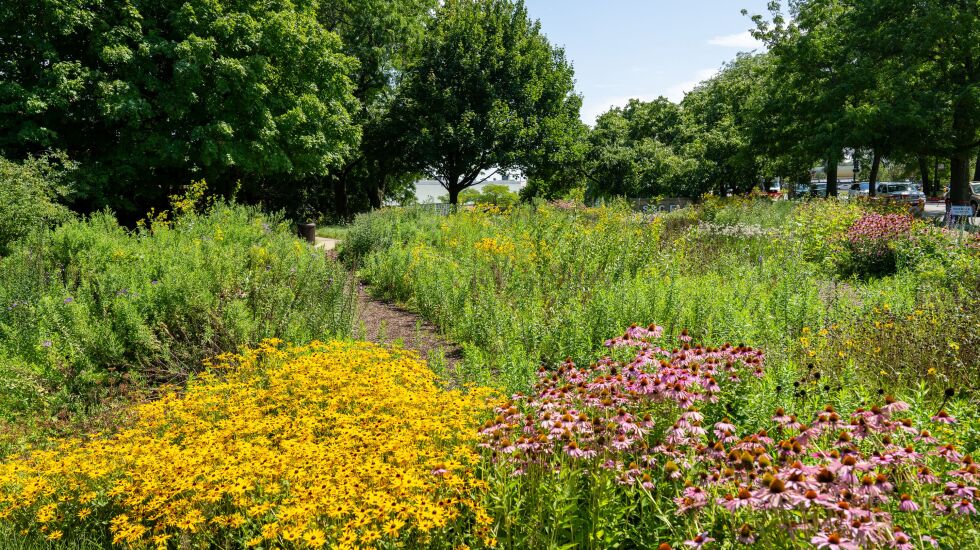
Rogers Park resident Neil Smith’s daily summer strolls with his 5-year-old daughter, Amelia, often include a stop to see the colorful wildflowers, buzzing bees and chirping birds at the intersection of Pratt and Ridge boulevards.
“It’s a pleasure to walk by and see this,” Smith said. “Any green space in the city, especially for bees and butterflies, is crucial.”
There wasn’t always so much to see on the street corner. Smith watched with anticipation last year as a team of landscapers crafted a garden on the once-vacant patch of grass.
S&C Electric Co., a Rogers Park-based electrical equipment maker, last month unveiled the Arlys Conrad Memorial Park and Native Pollinator Garden, a 12,5000-square-foot garden on the northwest corner of the company’s 46-acre campus. The garden is the result of a nearly four-year effort.
At the garden, bees, birds and butterflies flutter in harmony amid a mix of colorful prairie and woodland plants that bloom year round. The park is named after Arlys Conrad, the late wife of S&C Electric founder John Conrad, who was known for her green thumb and dedication to the company. She died in 2007.
While the park was always open to the public, it lacked much color and life, said Brian Kane, S&C Electric’s senior safety and environmental affairs manager, who helped lead the garden project.
Now, the garden boasts 45 plant species showcasing shades of purple, yellow, red and orange. Kane said he likes the garden’s purple coneflowers, which provide lots of nectar for bees and butterflies.

S&C Electric, one of the largest employers on the city’s North Side that’s been in Rogers Park for over 75 years, is constantly looking for ways to expand its environmental efforts, Kane said. The company sought out a partnership with the Field Museum after seeing a presentation in 2019 about the museum’s Keller Science Action Center transforming industrial land across the Midwest into native gardens.
“We got to do some fun field trips back and forth, looking at our campus and then we went and visited the Field Museum that has some amazing native gardens,” Kane said.
S&C Electric employees explored the Field Museum’s Rice Native Gardens and picked out the specific plants they liked, crafting a vision for what a garden would look like at the company’s campus.
Work on the project began in spring 2022 as S&C Electric partnered with landscaping company Pizzo & Associates Ltd. to do the actual planting. Then, they waited.
“We watched [the garden] meticulously all summer,” Kane said. “We did see some nice progress late summer into the fall and that gave us the first idea that this is gonna look pretty nice. And now, when you come this year, it’s just amazing.”
More than just a peaceful space for visitors to enjoy, Kane said the garden increases biodiversity in the community, pulls carbon from the atmosphere and provides food and shelter for wildlife.
Ald. Maria Hadden (49th), a member of the City Council Environmental Protection and Energy Committee, said S&C’s undertaking “sets a powerful example for bigger electric corporations.”
“I believe the pollinator [garden] will serve as a model for sustainable urban design and community collaboration,” Hadden said. “Community members stand to gain not only a respite for reflection and enjoyment but also an urban oasis with fresher and cleaner air.”
Catherine Hu, a conservation ecologist at the Keller Science Action Center, said she appreciated seeing a company like S&C take on a community sustainability project.
Hu, who made the online field guide identifying some of the plants in the park, said the garden provides community members an opportunity to learn about the importance of native gardens, which feature plant species that grow naturally in an area to support pollinators and other wildlife.
“The plants particularly are important because they are the bottom of the food chain and they’re supporting the insects which are supporting birds and small mammals and then it goes up the food chain,” Hu said.
Kane said he hopes to see more community involvement with the garden and envisions partnering with local schools to hold events that allow students to learn about the plants and help with seed harvesting.
“We hope to be an inspiration to other local companies and organizations that can see how simple or relatively straightforward a project it is to plant a native landscaped garden that can be so impactful visually to the local community,” Kane said.







